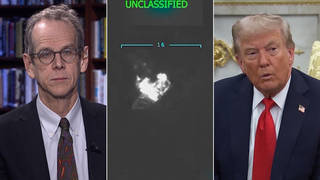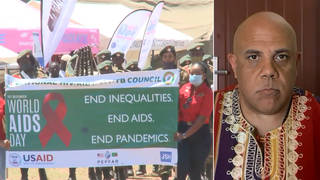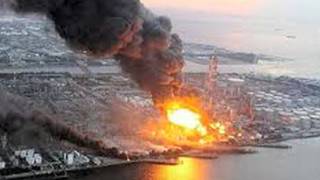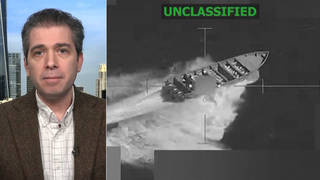
Guests
- Aileen Mioko Smithdirector of Kyoto-based Green Action. She is one of Japan’s leading voices challenging the production, commerce and transport of nuclear material, and calling for sustainable energy policies.
Japan is facing growing fears as radiation leaking from the badly damaged Fukushima Daiichi nuclear power station has contaminated food and water supplies. Bottled water was in short supply across Tokyo after Japanese authorities warned that tap water is too dangerous for consumption by infants. Thousands of people remain without potable water in areas of northern Japan ravaged by the earthquake and tsunami. We speak with Aileen Mioko Smith of Kyoto-based Green Action, one of Japan’s leading voices challenging the production, commerce and transport of nuclear material, and calling for sustainable energy policies. [includes rush transcript]
Transcript
JUAN GONZALEZ: Japan is facing growing fears radioactivity from an earthquake-stricken nuclear power station has contaminated food and water supplies. Australia, Hong Kong and Singapore are the latest countries to ban food imports from areas near Japan’s Fukushima nuclear power plant. The ban includes dairy products, vegetables, fruits, meat and seafood. The U.S. also halted some food imports on Tuesday.
The urgency of halting the spread of radioactive contamination from the site was underlined on Wednesday when Japanese authorities warned that infants should not drink tap water even in Tokyo, 140 miles southwest of the stricken plant. Tokyo residents say they are concerned about dangerously high levels of radioactive iodine in their water supply but are having trouble securing potable water.
AMY GOODMAN: Japanese authorities say they are considering a plan to import and distribute bottled water.
Meanwhile, the restoration of electricity at the Fukushima plant stirred hopes that the crisis was ebbing. But nuclear engineers say some of the most difficult and dangerous tasks are still ahead, and time is not on the side of the repair teams. The tasks include manually draining hundreds of gallons of radioactive water and venting radioactive gas from the pumps and piping of the emergency cooling systems, which are located diagonally underneath the overheated reactor vessels. On Monday evening, workers at the plant were evacuated after smoke began emanating from a building.
JUAN GONZALEZ: Japanese officials say the earthquake and tsunami have killed more than 9,300 people, and almost 14,000 are missing. Estimated damages have climbed to over $309 billion.
Joining us now is Aileen Mioko Smith. She’s the director of Kyoto-based Green Action and is one of Japan’s leading voices challenging the production, commerce and transport of nuclear material, and calling for sustainable energy policies. She joins us from San Francisco.
Welcome to Democracy Now!, Aileen Mioko Smith.
AILEEN MIOKO SMITH: Thank you very much.
JUAN GONZALEZ: Can you tell us the latest on the developments, especially the reports of the high levels of radiation in the water supply of Tokyo?
AILEEN MIOKO SMITH: Yes. The water supply of parts of Tokyo had levels higher than the standard for safety for infants. And even though that level went down a little bit, now we’re having the same problem in Saitama Prefecture and Chiba, adjoining Tokyo. So, the levels of iodine in the water — this is tap water — for infants is not considered safe, and therefore bottled water is being distributed.
JUAN GONZALEZ: Well, some people are speculating that the — given the reported levels of release of radiation from the plant, that this kind of — these amounts of radioactive iodine shouldn’t be showing up in the water, that perhaps this is an indication that the government has not given a full report on how much radiation was released earlier on.
AILEEN MIOKO SMITH: Absolutely. A few days ago, the French nuclear authority said that perhaps, up to now, the estimate could be about 10 percent of Chernobyl releases. And then, yesterday, the Austrian meteorological agency said that probably the estimates would be about 20 percent to 50 percent of what had been released at Chernobyl. So we’re talking very high levels, serious, serious levels.
Yesterday, the Japanese government admitted that 30 kilometers outside — this is not an evacuated zone — a person could have been exposed to as much as 100 millisieverts of radiation. That would be twice the amount of the evacuation threshold established by the International Atomic Energy Agency and the World Health Organization. And yet, the Japanese government refuses to evacuate people from beyond a 20-kilometer — that’s a 12-mile — area. And just an hour ago, up to 23 Diet members of the Japanese national parliament have issued a statement saying that immediate evacuation, drastically increasing the area outside of that 30-kilometer zone right now, should happen. And immediately, at the very beginning, pregnant women and preschool-aged children should be evacuated from this area that still hasn’t been evacuated. It’s about a 20-mile area right now.
AMY GOODMAN: Aileen Mioko Smith, can you talk about the tainted food?
AILEEN MIOKO SMITH: Yes. The food, the more the sampling — the sampling has been intensified, so the types of food that is contaminated is increasing. They’re finding more. Up to now, 11 types of food have been found contaminated. And, of course, export of this food from the four prefectures has been banned outside, you know, not sending it outside.
And the soil contamination is really high. Soil found 40 kilometers away — now, remember, it’s still 30 kilometers indoors, stay indoors; 20 kilometers, evacuation. So, beyond that area, for example, north-northwest in Imatate, the levels on the soil were very high — in fact, a thousand times iodine, 4,000 times the cesium standard. And we just got a report from the Kyoto Research Reactor Institute, Dr. Tetsuji Imanaka, that said that — he had to look a little bit more into the sampling of the Japanese government, but depending on how the sampling was done, this level of contamination in the soil could be twice the amount that was compulsory evacuation for Chernobyl. So, we’re looking at very high levels in the soil in some parts. It’s difficult to know what the whole picture is, but some parts are very highly contaminated. And of course that would result in food contamination.
AMY GOODMAN: What is your assessment of the situation right now, Aileen Mioko Smith? You’ve been highly critical about the information coming out. What are people saying to you on the ground? You’re following this 24 hours a day.
AILEEN MIOKO SMITH: Well, our key concern is evacuation. And really, evacuation should have been proactive. And the later you delay, the more you would expose people who are trying to evacuate, who are going out and outdoors to evacuate, to levels of radiation exposure, and we don’t want that to happen. So we’re urging the Japanese government. Now Diet members are urging evacuation.
JUAN GONZALEZ: And in terms of the plants themselves, the efforts to gain control of the plants and to assure that both the spent fuel pools and the reactors do not continue to heat up, how has that been going?
AILEEN MIOKO SMITH: Well, it’s still touch and go. We don’t know really what’s going to be happening the next 12 hours, 24 hours, over the several days. Right now, highly concern is Unit 1, the containment inside. The pressure is building. And if they allow the pressure to build too much, it could crack the containment. So then what has to be done is to vent, and that means lots of radiation release. And so, that’s a concern. And then, the spent nuclear fuel pools, still multiple, is a concern.
And I just want to address that the Japanese government’s earthquake reinforcement requirements, the standards that are in place, even today, at all the nuclear power plants in Japan, is really a travesty. And actually, the Fukushima plant was operating under 1978 guidelines. The new guidelines had been established in 2006, but even those guidelines underestimated this earthquake. The earthquake that happened in Fukushima this time was 140 times or so more than the maximum that was estimated under these new guidelines. And the new guidelines didn’t even take into consideration anything beyond the outer containment, and it didn’t even take into consideration the spent nuclear fuel pools. And so, these are the new guidelines. And this plant was operating on old guidelines that were even worse. And right now we have other plants, like the Hamaoka plant near Tokyo, that we thought would go first. It’s seismically a lot more dangerous than Fukushima. So, this is a total result of — it’s a democracy issue — and total result of Japan not — the government not requiring standards for earthquake for a nuclear power plant.
AMY GOODMAN: Aileen Mioko Smith, can you talk about the resonance that people must be feeling, especially older people, to what happened in 1945, the dawn of nuclear age, Japan being the target of the U.S. nuclear bombs, the first to be dropped in the world, two, on Hiroshima and Nagasaki, the aftermath, the radiation poisoning, the sickness, the numbers of people who died? So now it’s 66 years later. People are being told to stay inside. You have workers in the plants, unbelievably brave, who are contaminated, who are saying they’ll stay because they’re contaminated already, so trying to deal with these nuclear plants. Has this opened up a discussion, from nuclear weapons to nuclear power and where you go from here?
AILEEN MIOKO SMITH: Well, I think that — well, unfortunately, the Japanese government hasn’t said that it will officially put a hold on all new nuclear power plant builds, or neither has it said that it will not be giving a life extension for the older plants in Japan to be able to operate longer. So, nothing has changed yet in Japan.
I think that, you know, the Japanese public is very concerned about radiation, of course, because they know what happened — you know, Hiroshima and Nagasaki, the latent effects — and so, there was a concern. But the PR, the ability of the utilities, like Tokyo Electric, putting on full-page ads in the papers and on TV all the time, all the time, about how nuclear was safe and how it was necessary, that I think the Japanese public, a lot of them, felt that — well, one is, it was a necessary evil in a country that didn’t have energy, its own energy source, or that Japanese nuclear power must be safe. But that really wasn’t the case.
Every site in Japan — there are 54 nuclear plants — citizens, local citizens, had been addressing the dangers of nuclear power, especially the seismic issue, the earthquakes. But, you know, the government rubber-stamps the electric utility plans, and these electric utilities are tremendously powerful — I mean, so powerful that, for example, the long term plan for energy, for nuclear power, the committees that deliberate that — the Tokyo Electric president is head of the committee. That’s happened in the past. And even now, the deliberations that are going on since last — the end of last year, and it’s completely stacked. The committee is completely — you know, virtually pro-nuclear, a couple of token people allowed to be part of the committee. And the information supplied is just from the government Ministry of Economy, Trade and Industry. That has to change. That’s the thing that has to change in Japan.
JUAN GONZALEZ: I want to ask you about the impact of other countries’ assessments on what was going on there, because it’s my experience in covering many of these disasters over the years that the immediate government is always trying to downplay whatever happens in a disaster, in a major disaster. But then you had, in this case, the governments of France and the United States raising different issues, saying, “No, no. This is a lot bigger than what the Japanese government appears to be saying.” What that — the impact of what was happening in the rest of the world, other assessments, on the Japanese public and how they regard the reliability of their own government?
AILEEN MIOKO SMITH: Well, one is, it’s very easy for the U.S. and France to look over to the other side of the ocean and critique this, when actually there are serious problems at both countries with nuclear power.
I think that the Japanese citizens — the news is getting across about, for example, how other governments required, you know, their own citizens to evacuate from Tokyo. The area for people to get out was much, much larger, you know, 80 kilometers or even more than a hundred. And I think that citizens question the Japanese government, wondering, you know, why is the Japanese government so lax and so hesitant in implementing plans to protect people.
I think, right now — you know, everybody is probably feeling and thinking different things. You know, I have relatives who are still staying in Tokyo, and — but I have friends who have left. And it’s a big mixture. But I think that when infants are — families are told that infants should not be drinking the tap water, I think that that really — that you really start to, you know, worry about what’s going to happen next.
AMY GOODMAN: Aileen Mioko Smith, thank you very much for being with us, director of the Kyoto-based Green Action, one of Japan’s leading voices challenging the production, commerce and transport of nuclear material, calling for sustainable energy policies.












Media Options